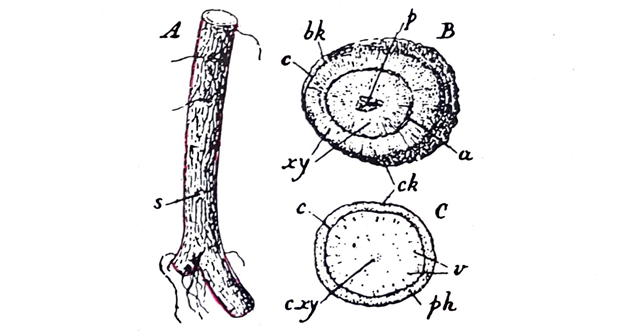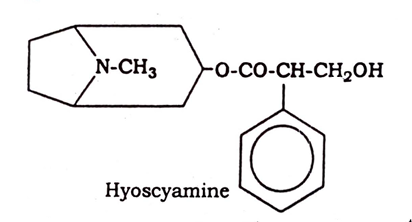Synonyms of Belladonna Root:
Belladonnae Radix, Deadly Nightshade Root.
Botanical Source:
Belladonna root consists of the dried roots and rootstocks of Atropa belladonna Linn. of the family Solanaceae.
Geographical Source:
Belladonna roots is obtained from plants cultivated in England, Rumania, Bulgaric1, Germany and U.S.A.

Fig. 55: Belladonna Root. A, portion of a young root; B, t.s. of root stock; C. t. s. of root. a, limit of year’s growth; bk, bark; c, cambium ck cork; c.xy, central mass of xylem; P pith; yh, phloem; s, scar of rootlet; v, vessel; xy, xylem. (Reproduced from Wals).
Belladonna Root Macroscopical Characters:
The roots are cylindrical in shape, 4 to 15 cm in length and up 4 cm in diameter. The outer surface is longitudinally furrowed, covered with a soft cork and marked with rootlet scars. It is yellowish brown in colour but whitish below the cork. Its fracture is short with a starch; fractured surface.
The transversely cut surface shows a distinct cambium line with a radially arranged wood in the old root and scattered bundles in the young root. The drug possesses a faintly musty odour and a bitter taste.
Microscopical Characters:
The woody part of the root contains centrally a small mass of porous primary xylem. The rest of it is composed of a secondary xylem tissue consisting of a parenchyma in which occur scattered groups of vessels accompanied by a few tracheids and fibers. The larger vessels possess oval or round, bordered pits. The phloem tissue outside the cambium is parenchymatous with groups of sieve tubes. Several layers of thin-walled cork cells from the outer part of the root. Idioblasts, containing sandy microsphenoidal crystals of calcium oxalate, occur in the parenchymatous tissue, which also contains small starch grains.
Chemical Constituents:
Belladonna root contains tropane alkaloids, the principal one being hyoscyamine. It also contains a small amount of hyoscine. Besides these, it contains a crystalline fluorescent compound, Beta-methyl aesculetin, tannin, starch and calcium oxalate.

Uses of Belladonna Root:
Belladonna root extract is externally used as a local anaesthetic and anodyne. Internally it is used to check sweating and other glandular secretions, as a sedative, antispasmodic and mydriatic agent.
Substitutes and adulterants:
The dried roots and rhizomes of a number of plants are used as substitutes and adulterants of Belladonna root. They include Atropa acuminata (Indian Belladonna), Phytolacca decandra, Scopolia Carniolaca and S. japonica.
